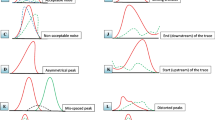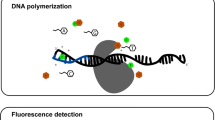Abstract
Key message
An innovative genotyping method designated as semi-thermal asymmetric reverse PCR (STARP) was developed for genotyping individual SNPs with improved accuracy, flexible throughputs, low operational costs, and high platform compatibility.
Abstract
Multiplex chip-based technology for genome-scale genotyping of single nucleotide polymorphisms (SNPs) has made great progress in the past two decades. However, PCR-based genotyping of individual SNPs still remains problematic in accuracy, throughput, simplicity, and/or operational costs as well as the compatibility with multiple platforms. Here, we report a novel SNP genotyping method designated semi-thermal asymmetric reverse PCR (STARP). In this method, genotyping assay was performed under unique PCR conditions using two universal priming element-adjustable primers (PEA-primers) and one group of three locus-specific primers: two asymmetrically modified allele-specific primers (AMAS-primers) and their common reverse primer. The two AMAS-primers each were substituted one base in different positions at their 3′ regions to significantly increase the amplification specificity of the two alleles and tailed at 5′ ends to provide priming sites for PEA-primers. The two PEA-primers were developed for common use in all genotyping assays to stringently target the PCR fragments generated by the two AMAS-primers with similar PCR efficiencies and for flexible detection using either gel-free fluorescence signals or gel-based size separation. The state-of-the-art primer design and unique PCR conditions endowed STARP with all the major advantages of high accuracy, flexible throughputs, simple assay design, low operational costs, and platform compatibility. In addition to SNPs, STARP can also be employed in genotyping of indels (insertion–deletion polymorphisms). As vast variations in DNA sequences are being unearthed by many genome sequencing projects and genotyping by sequencing, STARP will have wide applications across all biological organisms in agriculture, medicine, and forensics.




Similar content being viewed by others
References
Ayyadevara S, Thaden JJ, Reis RJS (2000) Discrimination of primer 3′-nucleotide mismatch by Taq DNA polymerase during polymerase chain reaction. Anal Biochem 284:11–18
Bachlava E, Taylor CA, Tang S, Bowers JE, Mandel JR, Burke JM, Knapp SJ (2012) SNP discovery and development of a high-density genotyping array for sunflower. PLoS One 7:e29814
Cha RS, Zarbl H, Keohavong P, Thilly WG (1992) Mismatch amplification mutation assay (MAMA): application to the c-H-ras gene. Genom Res 2:14–20
Huang MM, Arnheim N, Goodman MF (1992) Extension of base mispairs by Taq DNA polymerase: implications for single nucleotide discrimination in PCR. Nucleic Acids Res 20:4567–4573
International Rice Genome Sequencing Project (2005) The map-based sequence of the rice genome. Nature 436:793–800
Konieczny A, Ausubel FM (1993) A procedure for mapping Arabidopsis mutations using co-dominant ecotype-specific PCR-based markers. Plant J 4:403–410
Kwok S, Kellogg DE, McKinney N, Spasic D, Goda L, Levenson C, Sninsky JJ (1990) Effects of primer-template mismatches on the polymerase chain reaction: human immunodeficiency virus type 1 model studies. Nucleic Acids Res 18:999–1005
Liu J, Huang S, Sun M, Liu S, Liu Y, Wang W, Zhang X, Wang H, Hua W (2012) An improved allele-specific PCR primer design method for SNP marker analysis and its application. Plant Methods 8:34
Livak KJ (1999) Allelic discrimination using fluorogenic probes and the 5′ nuclease assay. Genet Anal 14:143–149
Livak KJ, Flood SJ, Marmaro J, Giusti W, Deetz K (1995) Oligonucleotides with fluorescent dyes at opposite ends provide a quenched probe system useful for detecting PCR product and nucleic acid hybridization. Genom Res 4:357–362
Myakishev MV, Khripin Y, Hu S, Hamer DH (2001) High throughput SNP genotyping by allele-specific PCR with universal energy-transfer-labeled primers. Genom Res 11:163–169
Neff MM, Neff JD, Chory J, Pepper AE (1998) A simple technique for the genetic analysis of single nucleotide polymorphisms: experimental applications in Arabidopsis thaliana genetics. Plant J 14:387–392
Newton CR, Graham A, Heptinstall LE, Summer SJ, Kalsheker N, Smith JC, Markham AF (1989) Analysis of any point mutation in DNA. The amplification refractory mutation system (ARMS). Nucleic Acid Res 17:2503–2516
Pastinen T, Kurg A, Metspalu A, Peltonen L, Syvänen AC (1997) Minisequencing: a specific tool for DNA analysis and diagnostics on oligonucleotide arrays. Genome Res 7:606–614
Peyret N, Seneviratne PA, Allawi Jr HT, SantaLucia J (1999) Nearest-neighbor thermodynamics and NMR of DNA sequences with internal A∙A, C∙C, G∙G, and T∙T mismatches. Biochemistry 38:3468–3477
Semagn K, Babu R, Hearne S, Olse M (2014) Single nucleotide polymorphism genotyping using Kompetitive Allele Specific PCR (KASP): overview of the technology and its application in crop improvement. Mol Breed 33:1–14
Stadhouders R, Pas SD, Anber J, Voermans J, Mes TH, Schutten M (2010) The effect of primer-template mismatches on the detection and quantification of nucleic acids using the 5′_ nuclease assay. J Mol Diagn 12:109–117
Syvänen AC (2001) Accessing genetic variation: genotyping single nucleotide polymorphism. Nat Rev Genet 2:930–942
Syvänen AC, Aalto-Setälä K, Harju L, Kontula K, Söderlund H (1990) A primer-guided nucleotide incorporation assay in the genotyping of apolipoprotein E. Genomics 8:684–692
Taylor S, Scott R, Kurtz R, Fisher C, Patel V, Bizouarn F, (2010) A practical guide to high resolution melt analysis genotyping. BioRad Tech Note 6004
Tyagi S, Kramer FR (1996) Molecular beacons: probes that fluoresce upon hybridization. Nat Biotechnol 14:303–308
Tyagi S, Bratu DP, Kramer FR (1998) Multicolor molecular beacons for allele discrimination. Nat Biotechnol 16:49–53
Whitcombe D, Theaker J, Guy SP, Brown T, Little S (1999) Detection of PCR products using self-probing amplicons and fluorescence. Nat Biotechnol 17:804–807
Acknowledgements
We thank Drs. Yiqun Weng and Zengcui Zhang for critically reviewing this manuscript. This research was supported by the USDA-ARS National Sclerotinia Initiative, Grant No. 5442-21220-028-00D and the USDA-ARS CRIS Project No. 3060-21000-039-00D. Mention of trade names or commercial products in this article is solely for the purpose of providing specific information and does not imply recommendation or endorsement by the U.S. Department of Agriculture. USDA is an equal opportunity provider and employer.
Author information
Authors and Affiliations
Corresponding author
Ethics declarations
Conflict of interest
The authors declare that they have no conflict of interest.
Ethical standards
The experiments were performed in compliance with the current laws of the USA.
Additional information
Communicated by X. Xia.
Electronic supplementary material
Below is the link to the electronic supplementary material.
Rights and permissions
About this article
Cite this article
Long, Y.M., Chao, W.S., Ma, G.J. et al. An innovative SNP genotyping method adapting to multiple platforms and throughputs. Theor Appl Genet 130, 597–607 (2017). https://doi.org/10.1007/s00122-016-2838-4
Received:
Accepted:
Published:
Issue Date:
DOI: https://doi.org/10.1007/s00122-016-2838-4




